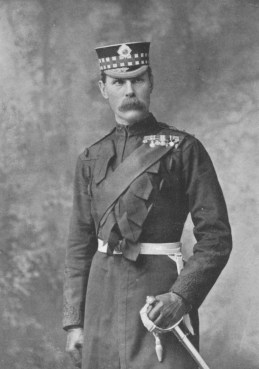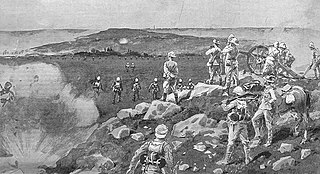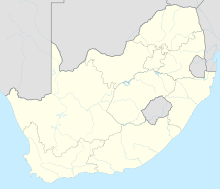
The Second Boer War, also known as the Boer War, Transvaal War, Anglo–Boer War, or South African War, was a conflict fought between the British Empire and the two Boer republics over the Empire's influence in Southern Africa.

Jacobus Herculaas de la Rey, better known as Koos de la Rey, was a South African military officer who served as a Boer general during the Second Boer War. De la Rey also had a political career and was one of the leading advocates of Boer independence. His death at the hands of the South African Police under controversial circumstances had a major role in sparking the Maritz rebellion.

The 1st Division is an infantry division of the British Army that has been formed and disestablished numerous times since 1809 and is still currently active as the 1st Division. Lieutenant-General Arthur Wellesley raised the division for service in the Peninsular War, which was part of the Coalition Wars of the Napoleonic Wars. The division was disestablished in 1814 but reformed the following year for service in the War of the Seventh Coalition. It then fought at the Battle of Waterloo, where it repulsed numerous attacks, including the final attack of the day that was launched by the French Imperial Guard. Following the battle, the division marched into France and became part of the Army of Occupation before being disbanded a few years later.

The 6th Division was a division of the British Army, which had been raised and disbanded numerous times as needed over the last 200 years. It was first established by Lieutenant-General Arthur Wellesley in 1810, for service in the Peninsular War as part of the Anglo-Portuguese Army. Over the following four years, the division took part in numerous battles and sieges. Notably, on 22 July 1812, the division was heavily engaged during the Battle of Salamanca and suffered the most casualties of any allied formation in that battle. Following the invasion of France, the formation played a prominent role in the 1814 Battle of Toulouse where it assaulted and seized numerous French redoubts protecting the city. While successful, the formation suffered heavy losses from the fighting. This battle marked the end of the Peninsular War and the War of the Sixth Coalition, and the division was broken-up. It was reformed and active for most of the following year, during the War of the Seventh Coalition; held in reserve at the beginning of the Battle of Waterloo, it was committed in the evening to bolster the centre-left of the British line and suffered heavy casualties in the process.

The first day on the Somme was the beginning of the Battle of Albert (1–13 July) the name given by the British to the first two weeks of the Battle of the Somme in the First World War. Nine corps of the French Sixth Army and the British Fourth and Third armies attacked the German 2nd Army. The attack was from Foucaucourt south of the Somme, northwards across the Somme and the Ancre to Serre and Gommecourt, 2 mi (3.2 km) beyond, in the Third Army area. The objective of the attack was to capture the German first and second defensive positions from Serre south to the Albert–Bapaume road and the first position from the road south to Foucaucourt.
Black Week refers to the week of Sunday 10 December – Sunday 17 December 1899 during the Second Boer War, when the British Army suffered three devastating defeats by the Boer Republics at the battles of Stormberg on Sunday 10 December, Magersfontein on Monday 11 December and Colenso on Friday 15 December 1899. In total, 2,776 British soldiers were killed, wounded and captured during this period.
Jacobsdal is a small farming town in the Free State province of South Africa with various crops under irrigation, such as grapes, potatoes, lucerne, and groundnuts. The town was laid out in 1859 by Christoffel Jacobs on his farm Kalkfontein, and its last recorded population was 3,504.

The Battle of Modder River was an engagement in the Boer War, fought at Modder River, on 28 November 1899. A British column under Lord Methuen, that was attempting to relieve the besieged town of Kimberley, forced Boers under General Piet Cronjé to retreat to Magersfontein, but suffered heavy casualties altogether.

The SecondBattle of Colenso, also known as the Battle of Colenso, was the third and final battle fought during the Black Week of the Second Boer War. It was fought between British and Boer forces from the independent South African Republic and Orange Free State in and around Colenso, Natal, South Africa on 15 December 1899.

The Battle of Paardeberg or Perdeberg was a major battle during the Second Anglo-Boer War. It was fought near Paardeberg Drift on the banks of the Modder River in the Orange Free State near Kimberley.

The Battle of Magersfontein was fought on 11 December 1899, at Magersfontein, near Kimberley, South Africa, on the borders of the Cape Colony and the independent republic of the Orange Free State. British forces under Lieutenant General Lord Methuen were advancing north along the railway line from the Cape to relieve the siege of Kimberley, but their path was blocked at Magersfontein by a Boer force that was entrenched in the surrounding hills. The British had already fought a series of battles with the Boers, most recently at Modder River, where the advance was temporarily halted.
The 14th Infantry Brigade was a British Army formation during the Second Boer War, World War I, when it served on the Western Front, and World War II, when it fought in Crete and Tobruk, and then as Chindits in Burma.

The siege of Kimberley took place during the Second Boer War at Kimberley, Cape Colony, when Boer forces from the Orange Free State and the Transvaal besieged the diamond mining town. The Boers moved quickly to try to capture the area when war broke out between the British and the two Boer republics in October 1899. The town was ill-prepared, but the defenders organised an energetic and effective improvised defence that was able to prevent it from being taken.

The Battle of Poplar Grove was an incident on 7 March 1900 during the Second Boer War in South Africa. It followed on from the Relief of Kimberley as the British Army moved to take the Boer capital of Bloemfontein. The Boers were demoralised following the surrender of Piet Cronjé at the Battle of Paardeberg. General Sir John French's cavalry attacked the Boer force from the rear while mounted infantry and horse artillery attacked from the right flank. The Boers abandoned their positions in panic before the cavalry. The commander-in-chief of the Free State forces, Christiaan de Wet, in his book called the chapter on the subject "Wild Flight from Poplar Grove". This battle was followed by the Battle of Driefontein on March 10, 1900.

The military history of Australia during the Boer War is complex, and includes a period of history in which the six formerly autonomous British Australian colonies federated to become the Commonwealth of Australia. At the outbreak of the Second Boer War, each of these separate colonies maintained their own, independent military forces, but by the cessation of hostilities, these six armies had come under a centralised command to form the Australian Army.

The Battle of Elands River was an engagement of the Second Boer War that took place between 4 and 16 August 1900 in western Transvaal. The battle was fought at Brakfontein Drift near the Elands River between a force of 2,000 to 3,000 Boers and a garrison of 500 Australian, Rhodesian, Canadian and British soldiers, which was stationed there to protect a British supply dump that had been established along the route between Mafeking and Pretoria. The Boer force, which consisted of several commandos under the overall leadership of Koos de la Rey, was in desperate need of provisions after earlier fighting had cut it off from its support base. As a result, it was decided to attack the garrison along the Elands River in an effort to capture the supplies located there.
21st Brigade was an infantry formation of the British Army first organised in the Second Boer War, when it took part in Ian Hamilton's March from Bloemfontein to Pretoria. Reformed in World War I it served under the command of first 7th Division and then 30th Division, fighting in most of the major battles on the Western Front from the First Battle of Ypres to the Armistice. It was briefly re-raised in the Sudan early in World War II before being transferred to the Indian Army.

The Battle of Boshof was fought during the Second Boer War on 5 April 1900 between British forces and mostly French volunteers of the Boer army.

The Capture of Beaumont-Hamel was a tactical incident that took place during the Battle of the Somme in the Battle of the Ancre (13–18 November) during the second British attempt to take the village. Beaumont-Hamel is a commune in the Somme department of Picardy in northern France. The village had been attacked on 1 July, the First Day of the Somme. The German 2nd Army defeated the attack, inflicting many British and Newfoundland Regiment casualties.

The Battle of Doornkop was fought during Lord Roberts' advance on Pretoria in May and June 1900.
















